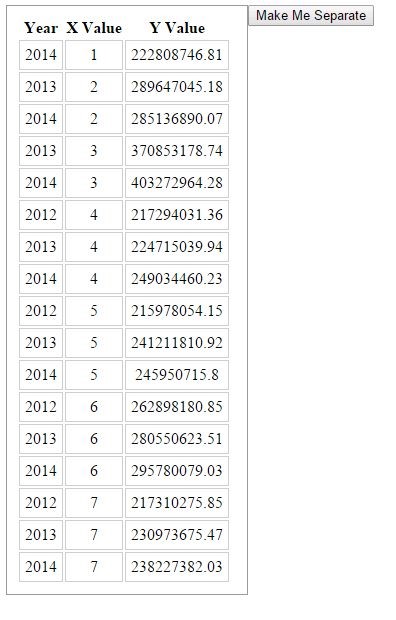Introduction
Today, this tip explains how to find the objects with the same property from a JSON and separate them to be shown in the UI. I hope you will like it.
Background
Yesterday, I came across a situation where there was a need to find the objects with the same property from some JSON data and separate them. So I thought of sharing that with you all.
Using the Code
First of all, we will add a jQuery reference as in the following code snippet:
<script src="jquery-2.1.4.min.js"></script>
Now we need some data, right? Please have a look at the following JSON data:
var data = '[{"name":2014,"data":
[{"x":"1","y":222808746.81}]},{"name":2013,
"data":[{"x":"2","y":289647045.18}]},
{"name":2014,"data":[{"x":"2","y":285136890.07}]},
{"name":2013,"data":[{"x":"3","y":370853178.74}]},
{"name":2014,"data":[{"x":"3","y":403272964.28}]},
{"name":2012,"data":[{"x":"4","y":217294031.36}]},
{"name":2013,"data":[{"x":"4","y":224715039.94}]},
{"name":2014,"data":[{"x":"4","y":249034460.23}]},
{"name":2012,"data":[{"x":"5","y":215978054.15}]},
{"name":2013,"data":[{"x":"5","y":241211810.92}]},
{"name":2014,"data":[{"x":"5","y":245950715.8}]},
{"name":2012,"data":[{"x":"6","y":262898180.85}]},
{"name":2013,"data":[{"x":"6","y":280550623.51}]},
{"name":2014,"data":[{"x":"6","y":295780079.03}]},
{"name":2012,"data":[{"x":"7","y":217310275.85}]},
{"name":2013,"data":[{"x":"7","y":230973675.47}]},
{"name":2014,"data":[{"x":"7","y":238227382.03}]}]';
Next, we need some UI elements as in the following:
<div id="initialData"></div>
<div id="newData"></div>
<button id="separateme">Make Me Separate</button>
What next? We need to show this data to our UI, right? For that, I am calling a function in our document ready function.
$(function () {
$('#newData').hide();
loadinitialData();
});
The following is the function definition for the loadinitialData() function.
function loadinitialData() {
jsonObject = $.parseJSON(data);
var html = '<table><th>Year<
/th><th>X Value</th><th>Y Value</th>';
for (i = 0; i < jsonObject.length; i++) {
html += '<tr><td>' + jsonObject[i].name +
'</td><td>' + jsonObject[i].data[0].x +
'</td><td>' +
jsonObject[i].data[0].y + '</td></tr>';
}
html += '</table>';
$('#initialData').append(html);
}
What we are doing here is parsing our data and appending the data to our UI element using a for loop.
Now after running it, you will get the following output:

We have successfully formatted our data and shown it to our UI. Cool, right?
So shall we go and separate our data? I guess you said "Yes". Awesome. Now we will create a click event for our "Make me sort" button as in the following:
$('#separateme').click(function () {
loadnewData();
$('#separateme').hide();
$('#newData').show();
});
Here is the definition of the loadnewData() function.
function loadnewData() {
for (i = 0; i < uniqueNames.length; i++) {
var currentName = uniqueNames[i];
var uniqueDataArray = $.grep(jsonObject, function (data) {
return data.name == currentName;
});
var html = '<table><th>Year</th>
<th>X Value</th><th>Y Value</th>';
for (j = 0; j < uniqueDataArray.length; j++) {
html += '<tr><td>' + uniqueDataArray[j].name +
'</td><td>' + uniqueDataArray[j].data[0].x
+ '</td><td>' + uniqueDataArray[j].data[0].y + '</td></tr>';
}
html += '</table>';
$('#newData').append(html);
}
}
Now, I guess you could determine the difference of both the loadinitialData() and loadnewData() functions. Yeah, you are right, we are using a function "grep" there.
var uniqueDataArray = $.grep(jsonObject, function (data) {
return data.name == currentName;
});
What our "grep" function does is, it will take all objects at a time that has the property "name" as currentName.
return data.name == currentName;
Once that is done, we will create a separate HTML table for each property and bind it to our parent element. Shall we now look into the complete code? We have done everything.
Complete Code
<!DOCTYPE html>
<html>
<head>
<title>Find JSON Object by its property,separate and show demo - Sibeesh Passion</title>
<script src="jquery-2.1.4.min.js"></script>
<style>
#initialData {
border: 1px solid #999;
width:220px;
padding:10px;
float:left;
}
#newData {
border: 1px solid #999;
width:220px;
padding:10px;
float:left;
}
td {
border: 1px solid #ccc;
padding: 5px;
text-align: center;
}
</style>
<script>
var data = '[{"name":2014,"data"
:[{"x":"1","y":222808746.81}]},
{"name":2013,"data":[{"x":"2",
"y":289647045.18}]},{"name":2014,"data":
[{"x":"2","y":285136890.07}]},
{"name":2013,"data":[{"x":"3",
"y":370853178.74}]},{"name":2014,"data":
[{"x":"3","y":403272964.28}]},
{"name":2012,"data":[{"x":"4",
"y":217294031.36}]},{"name":2013,"data":
[{"x":"4","y":224715039.94}]},{"name":2014,
"data":[{"x":"4","y":249034460.23}]},
{"name":2012,"data":[{"x":"5",
"y":215978054.15}]},{"name":2013,"data":
[{"x":"5","y":241211810.92}]},{"name":2014,
"data":[{"x":"5","y":245950715.8}]},
{"name":2012,"data":[{"x":"6",
"y":262898180.85}]},{"name":2013,"data":
[{"x":"6","y":280550623.51}]},
{"name":2014,"data":[{"x":"6",
"y":295780079.03}]},{"name":2012,"data":
[{"x":"7","y":217310275.85}]},{"name":2013,
"data":[{"x":"7","y":230973675.47}]},
{"name":2014,"data":
[{"x":"7","y":238227382.03}]}]';
var jsonObject;
var uniqueNames = [2013, 2012, 2014];
$(function () {
$('#newData').hide();
loadinitialData();
$('#separateme').click(function () {
loadnewData();
$('#separateme').hide();
$('#newData').show();
});
});
function loadinitialData() {
jsonObject = $.parseJSON(data);
var html = '<table><th>Year</th>
<th>X Value</th><th>Y Value</th>';
for (i = 0; i < jsonObject.length; i++) {
html += '<tr><td>' + jsonObject[i].name + '</td><td>' +
jsonObject[i].data[0].x + '</td>
<td>' + jsonObject[i].data[0].y + '</td></tr>';
}
html += '</table>';
$('#initialData').append(html);
}
function loadnewData() {
for (i = 0; i < uniqueNames.length; i++) {
var currentName = uniqueNames[i];
var uniqueDataArray = $.grep(jsonObject, function (data) {
return data.name == currentName;
});
var html = '<table><th>Year</th>
<th>X Value</th><th>Y Value</th>';
for (j = 0; j < uniqueDataArray.length; j++) {
html += '<tr><td>' + uniqueDataArray[j].name +
'</td><td>' + uniqueDataArray[j].data
[0].x + '</td><td>' +
uniqueDataArray[j].data[0].y + '</td></tr>';
}
html += '</table>';
$('#newData').append(html);
}
}
</script>
</head>
<body>
<div id="initialData"></div>
<div id="newData"></div>
<button id="separateme">Make Me Separate</button>
</body>
</html>
Now it is time to see our output as in the following:

You can find we have separated our object and shown it in a separate table. Cool. That is all for the day. I will return with another article soon.
Conclusion
I hope you liked this tip. Please share with me your valuable thoughts and comments. Your feedback is always welcome.
Thanks in advance. Happy coding!
History
- 10th June, 2015: Initial version
 General
General  News
News  Suggestion
Suggestion  Question
Question  Bug
Bug  Answer
Answer  Joke
Joke  Praise
Praise  Rant
Rant  Admin
Admin 







